Murder may be many things, but one thing it is not is biased. It is not swayed by a person’s ZIP code or tax bracket, by gender or religion.
In this two-part post let’s examine two cases of victims in opposite circumstances on opposite sides of town: a West Side socialite with money in the bank and an East Side homeless person with no shoes on his feet.
In early March 1992 former bank vice president Jack Koslow stood in the front yard of his pink brick townhouse at 4100 Clarke Avenue, just two blocks from the golf course of River Crest Country Club.
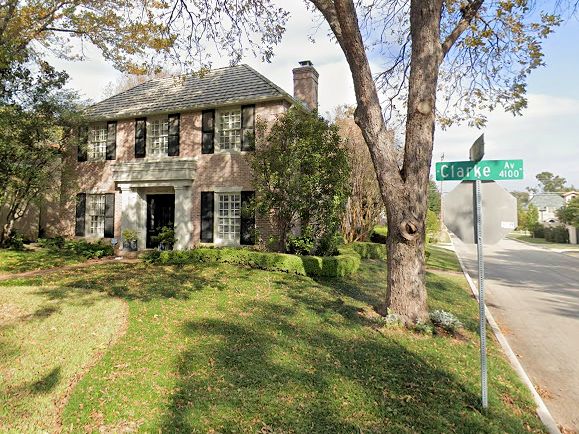 He watched as his adopted daughter, Kristi, seventeen, drove up with her boyfriend, Brian Salter.
He watched as his adopted daughter, Kristi, seventeen, drove up with her boyfriend, Brian Salter.
Koslow was surprised to see Kristi because father and daughter seldom interacted anymore.
Koslow and his first wife, Paula, had adopted Kristi when she was born. Kristi had been a troubled teenager, had associated with bad influences, had undergone counseling, had become estranged from Jack Koslow and was openly hostile to Koslow’s second wife, Caren. Kristi now lived with her adoptive mother, Paula.
If Jack Koslow was surprised to see Kristi drop by his house that day in 1992, he was even more surprised when Kristi walked up to him and gave him a kiss.
A few days later Jack Koslow would find out that he had been given the kiss of Judas.
Just before 4 a.m. on March 12 Jack Koslow, forty-eight, was awakened by Caren Koslow, forty, as she lay in bed beside him and screamed: “They’re in the house!”
The Koslows from their second-floor bedroom could hear voices downstairs. Then they heard footsteps ascending the stairs. Then outside the bedroom door voices yelled: “We’ve got guns” and “This is a robbery.”
The house was armed with a security system. The alarm had not sounded.
Jack Koslow got out of bed and went to a closet. As he was loading a shotgun two intruders kicked in the bedroom door. One carried a pistol. The other carried a pry bar. The intruders ordered the couple to lie face-down on the floor. Then one of the intruders began bludgeoning the Koslows with the pry bar.
The other intruder began searching the bedroom and found a knife.
Jack Koslow lost consciousness after hearing one of the intruders say, “Cut him here.”
When Koslow regained consciousness, the back of his head had been beaten, his neck had been slashed, and he had been stabbed multiple times. He found his wife lying in a pool of blood. She, too, had been beaten and stabbed multiple times. Her throat had been cut.
Koslow knelt beside his wife and tried to lift her. Then he realized that she was dead or dying.
Dazed, bloody, and wearing only boxer shorts, he stumbled downstairs and across the street to a neighbor’s house, where he called 911.
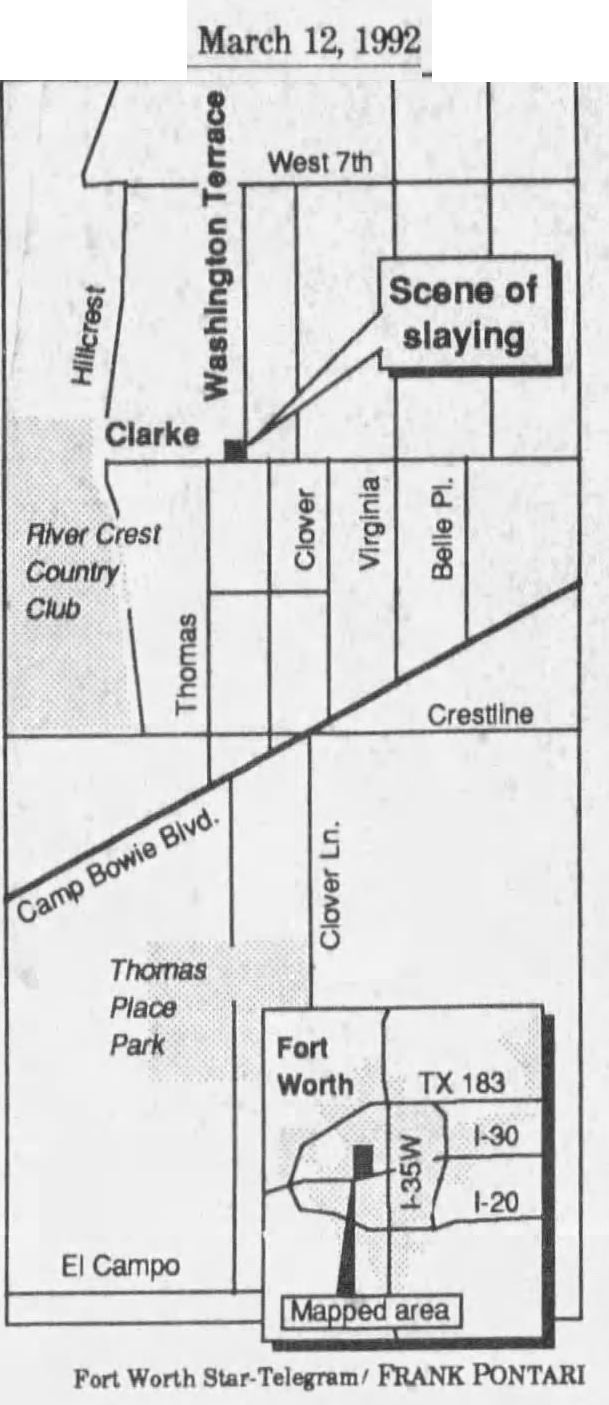 Caren Koslow was dead. Jack Koslow was severely wounded. The story dominated page 1 of the Star-Telegram. Neighbors of the Koslows were stunned.
Caren Koslow was dead. Jack Koslow was severely wounded. The story dominated page 1 of the Star-Telegram. Neighbors of the Koslows were stunned.
“All of the alarms, all of the security systems couldn’t stop this,” one neighbor said of the murder.
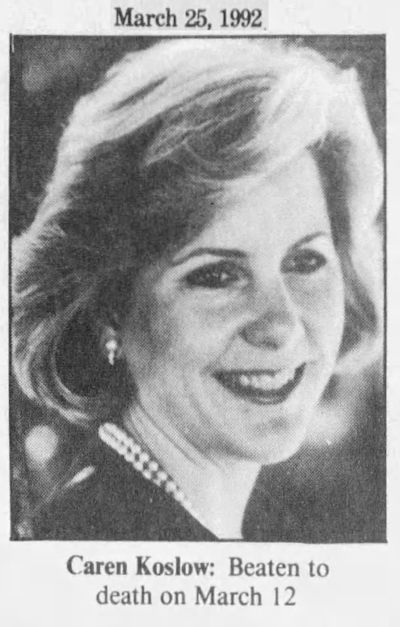 Upon learning of the crime, daughter Kristi Koslow told reporters that she was shocked and frightened.
Upon learning of the crime, daughter Kristi Koslow told reporters that she was shocked and frightened.
“We were as close as a stepdaughter and stepmother could be,” she claimed. “I don’t think anyone truly hated Caren. . . . It’s really scary.”
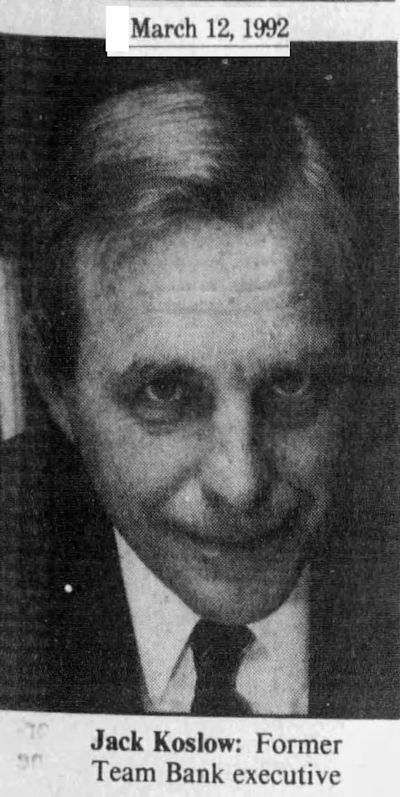 Although Jack Koslow was hospitalized in critical condition with a lacerated neck and numerous stab wounds, he immediately became a suspect. Yes, he had money of his own, but his wife had far more. She sprang from a wealthy Texas oil family. She had graduated from Country Day School in 1969, had been a member of the Assembly, and made her Steeplechase debut in 1971.
Although Jack Koslow was hospitalized in critical condition with a lacerated neck and numerous stab wounds, he immediately became a suspect. Yes, he had money of his own, but his wife had far more. She sprang from a wealthy Texas oil family. She had graduated from Country Day School in 1969, had been a member of the Assembly, and made her Steeplechase debut in 1971.
Associated Press writer Mike Cochran wrote that Caren’s friends described her as “a Yuppie American thoroughbred.”
The Koslows were active in the arts and charity: the symphony, the ballet, the Jewel Charity Ball, belonged to the country club, had a second home in Aspen.
Jack Koslow did not deny that the knife used in the attacks belonged to him. And the autopsy report on Caren Koslow conceded that she could have died before midnight. If she did, that would leave nearly four hours between the time she was attacked and the time Jack Koslow went to his neighbor’s home to report the crime.
Police had more questions. For example, why had the intruders not ransacked the house? Why had they taken very little from an affluent household? Who had deactivated the house’s security alarm? Why had Caren Koslow been killed but her husband spared? Why had Jack Koslow not phoned 911 from his own home?
Police read Jack Koslow his Miranda rights and questioned him several times. On the day of his wife’s funeral police asked Koslow, his head and neck still bandaged, for permission to take dental impressions from his wife’s corpse to check them against cuts on Koslow’s hands that might be teeth marks.
A source close to the investigation later said, “Pressure inside the police department was building from the top down. Jack Koslow was tried, convicted, and sentenced.”
But on March 24, twelve days after the murder and one day before police planned to arrest Koslow, police received a telephone call from a young man. He was frightened.
“I’ve got some things you need to take a look at,” he said.
Those things included bloody clothing and an equally bloody pry bar.
The informant said a friend had asked him to dispose of the items nearly two weeks earlier. The informant said his friend told him that he had used the pry bar to bludgeon the Koslows.
Just after midnight police converged on an Arlington video store and arrested clerk Jeffrey Dillingham, nineteen.
Then, based on information provided by Dillingham, before dawn police staked out the home of Jack Koslow’s ex-wife Paula and arrested Kristi Koslow and her boyfriend, Brian Salter, nineteen, as they backed a car from the driveway. Dillingham and Salter were acquaintances.
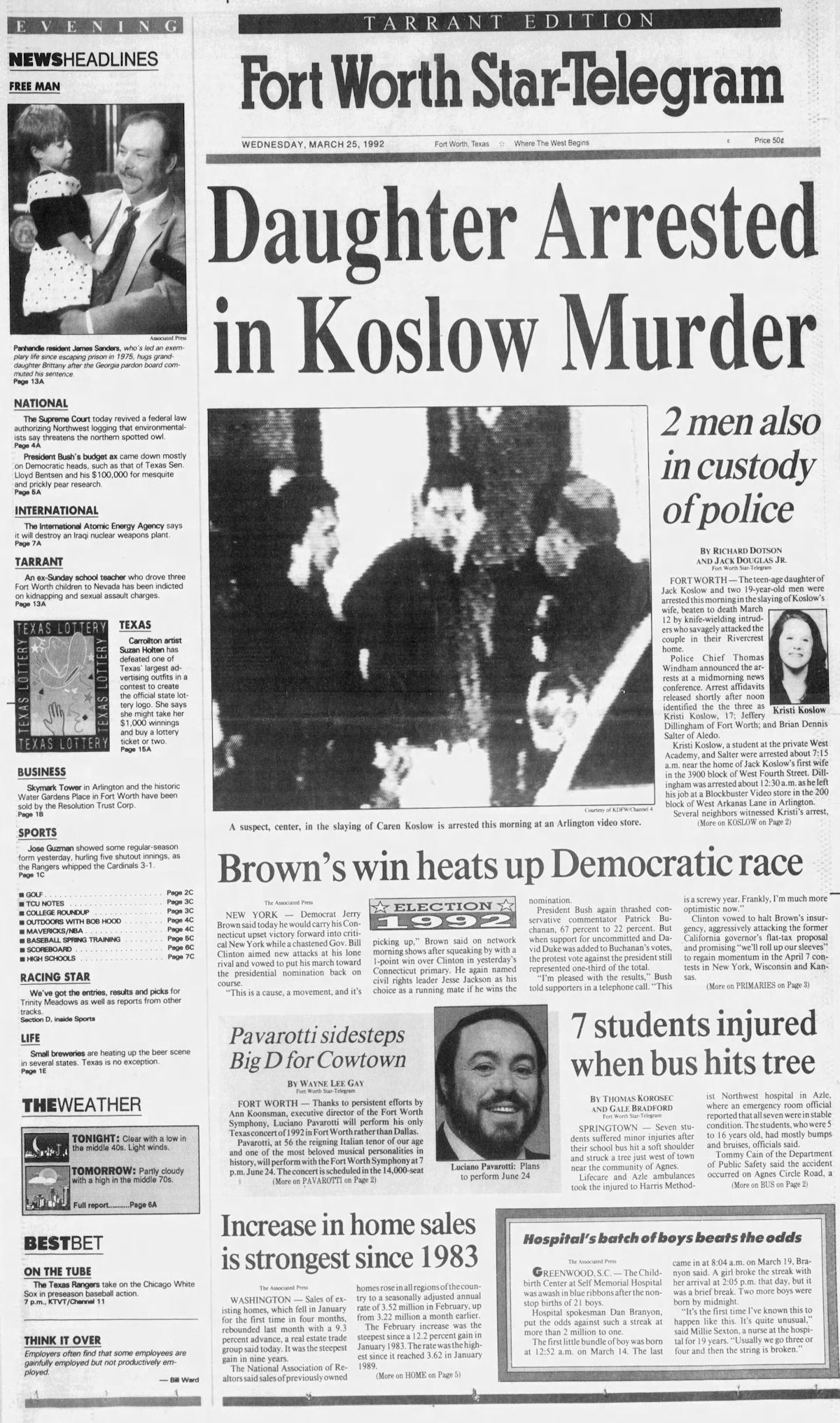 In a plot that reads like a teenage version of the plot to murder William P. Clark in 1953, Dillingham and Salter told police that Kristi Koslow wanted Salter and Dillingham to stage a robbery in order to kill Jack and Caren Koslow so that Kristi could inherit their money, which she estimated to be in the millions—enough that she offered each accomplice upward of $1 million to commit murder.
In a plot that reads like a teenage version of the plot to murder William P. Clark in 1953, Dillingham and Salter told police that Kristi Koslow wanted Salter and Dillingham to stage a robbery in order to kill Jack and Caren Koslow so that Kristi could inherit their money, which she estimated to be in the millions—enough that she offered each accomplice upward of $1 million to commit murder.
Salter told police: “She said that if just one of them died, the other one would get the money. But if both died that she would get it.”
Salter told police that after the three had agreed to the plan, he and Dillingham intended to kill the Koslows “four or five” times but that each time his nervousness stopped them from going through with the crime.
“I came up with excuses and canceled,” Salter told police.
“Prior to the night of the occurrence, the last meeting we had, I brought up the idea of just a burglary, and Jeff had said to me that he really wanted to do it the other way, to kill them.”
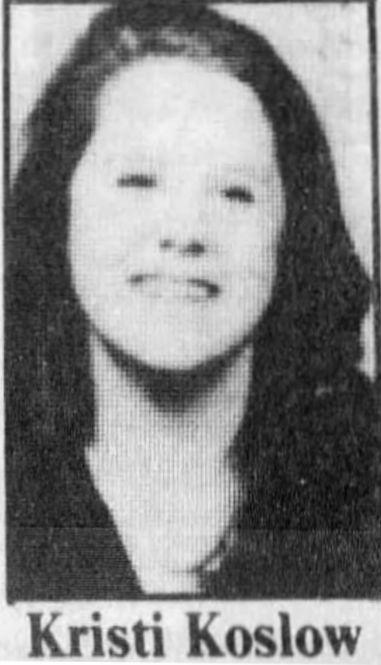 Salter told police that Kristi Koslow gave her accomplices the security system alarm code and a map of the house, including the stairway leading to the Koslows’ bedroom.
Salter told police that Kristi Koslow gave her accomplices the security system alarm code and a map of the house, including the stairway leading to the Koslows’ bedroom.
Police detective C. D. Brannan asked Salter whether Kristi Koslow told her accomplices how she wanted her parents killed.
“She just said do it quietly,” Salter told police.
Dillingham told police that after 3 a.m. on the night of the murder he pried open the back door of the Koslow house. As Salter punched in the code to deactivate the security alarm, Dillingham ran up the stairs and kicked in the door of the master bedroom.
Salter carried a .32-caliber pistol. Dillingham carried a pry bar.
“Mrs. Koslow was lying in bed,” Dillingham told police. “Mr. Koslow was going for the closet. I told him to get back and lay on the floor. By that time Brian was up there.
“. . . I stood for a couple of minutes in confusion because of what was going on.”
Then, Dillingham told police, Salter told him, “Do it.”
Dillingham told police: “I hit Mr. Koslow in the back of the head, on the neck with a pry bar. Then I hit Mrs. Koslow. I hit Mr. Koslow some more, and Mrs. Koslow started screaming. And then I hit Mrs. Koslow some more.”
(The blows from the pry bar made the suspected “teeth marks” on Jack Koslow’s hands.)
Dillingham told police that Kristi Koslow had told them that her parents kept several thousand dollars in the house. As Dillingham and Salter were searching for money, Salter found a knife.
Salter told police: “I saw him [Dillingham] slit Mrs. Koslow’s throat, but I turned around, and I didn’t see exactly what he did to Mr. Koslow.”
Then Salter’s pistol accidentally discharged into the floor, and the two intruders hastily fled.
“The gunshot saved [Jack] Koslow’s life,” a police investigator later said. “He was real, real lucky the gun went off.”
Salter told police that after the crime he telephoned Kristi Koslow and told her what had transpired. He said she asked if Jack and Caren were dead, and he told her he did not know.
“I hope they are,” Salter quoted Kristi Koslow as saying.
Kristi Koslow, Brian Salter, and Jeffrey Dillingham were indicted for capital murder and attempted capital murder.
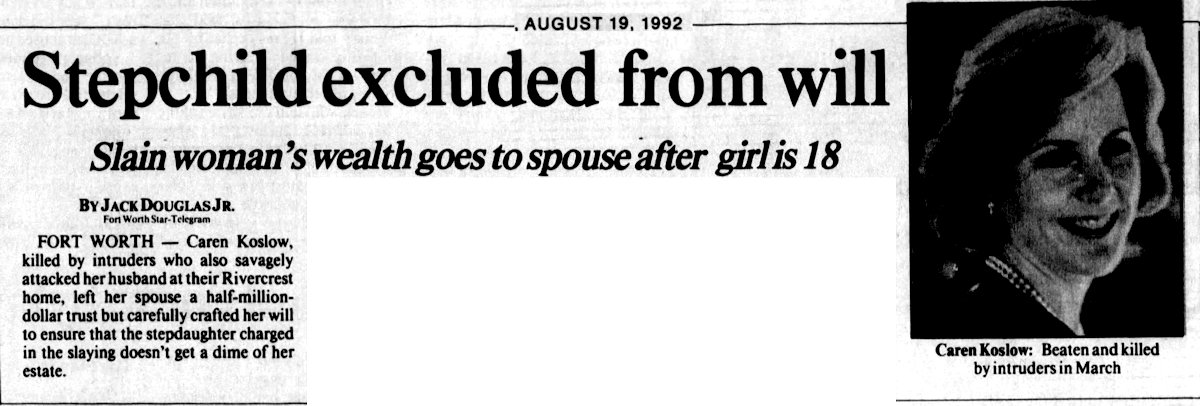 In August the Star-Telegram reported that Caren Koslow’s estate was valued at more than $1 million ($1.8 million today). Her will left $500,000 to Jack Koslow in a trust and nothing to Kristi. Furthermore, Jack Koslow would not receive any money from the trust until Kristi turned eighteen, ending his financial obligation to her. In other words, Kristi would not benefit from Caren’s will.
In August the Star-Telegram reported that Caren Koslow’s estate was valued at more than $1 million ($1.8 million today). Her will left $500,000 to Jack Koslow in a trust and nothing to Kristi. Furthermore, Jack Koslow would not receive any money from the trust until Kristi turned eighteen, ending his financial obligation to her. In other words, Kristi would not benefit from Caren’s will.
Kristi Koslow and her accomplices had done it all for nothing.
 Jeffrey Dillingham was the first of the conspirators to go on trial. He chose to take his chances with a jury rather than plead guilty to get a life sentence in exchange for testifying against the state’s primary target: Kristi Koslow.
Jeffrey Dillingham was the first of the conspirators to go on trial. He chose to take his chances with a jury rather than plead guilty to get a life sentence in exchange for testifying against the state’s primary target: Kristi Koslow.
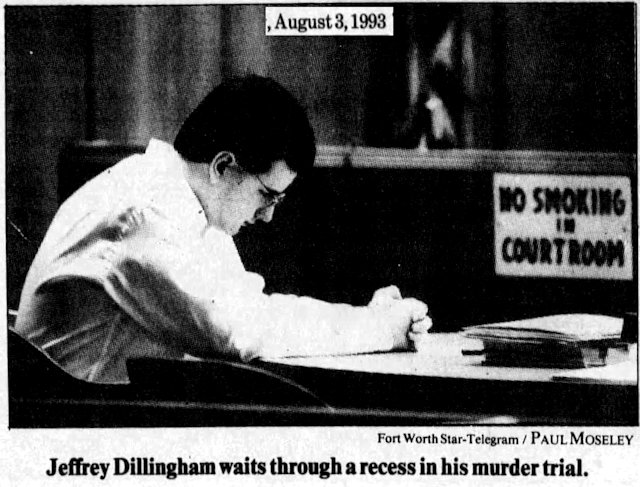 Jack Koslow testified at Dillingham’s trial, describing the attack on the night of March 12, 1992.
Jack Koslow testified at Dillingham’s trial, describing the attack on the night of March 12, 1992.
“I can feel them today,” he said of the blows to the back of his head.
But he said he could not identify his attackers.
Tarrant County prosecutor Robert Mayfield told the jury that Salter and Dillingham planned the crime carefully, bringing with them latex gloves and a bulletproof vest.
“In spite of Jack and Caren Koslow doing what they were ordered to do, they were hit on the back of the head with a hard object,” Mayfield said. Caren Koslow’s throat, Mayfield said, was cut “from ear to ear.”
Jack Koslow told the jury how his relationship with his daughter had soured. Koslow said Kristi lacked ambition, was self-centered, and associated with drug dealers and other people “with little regard for their personal being.”
He described Brian Salter, her boyfriend, as “a slug.”
Koslow said that Kristi Koslow had an IQ of 125 to 130, well above average, but never applied herself in school or anything else.
“She always took the wrong road,” he testified. “She would say, ‘I’m going to do good in school and apply myself,’ and you’d turn around, and she’d be doing just the opposite.”
He said that he and Caren did their best to motivate Kristi, sending her to a psychiatric program for emotionally disturbed teenagers.
Jack Koslow said that his relationship with Kristi began deteriorating when she was about thirteen and that by the time of the attack, “we had no relationship.”
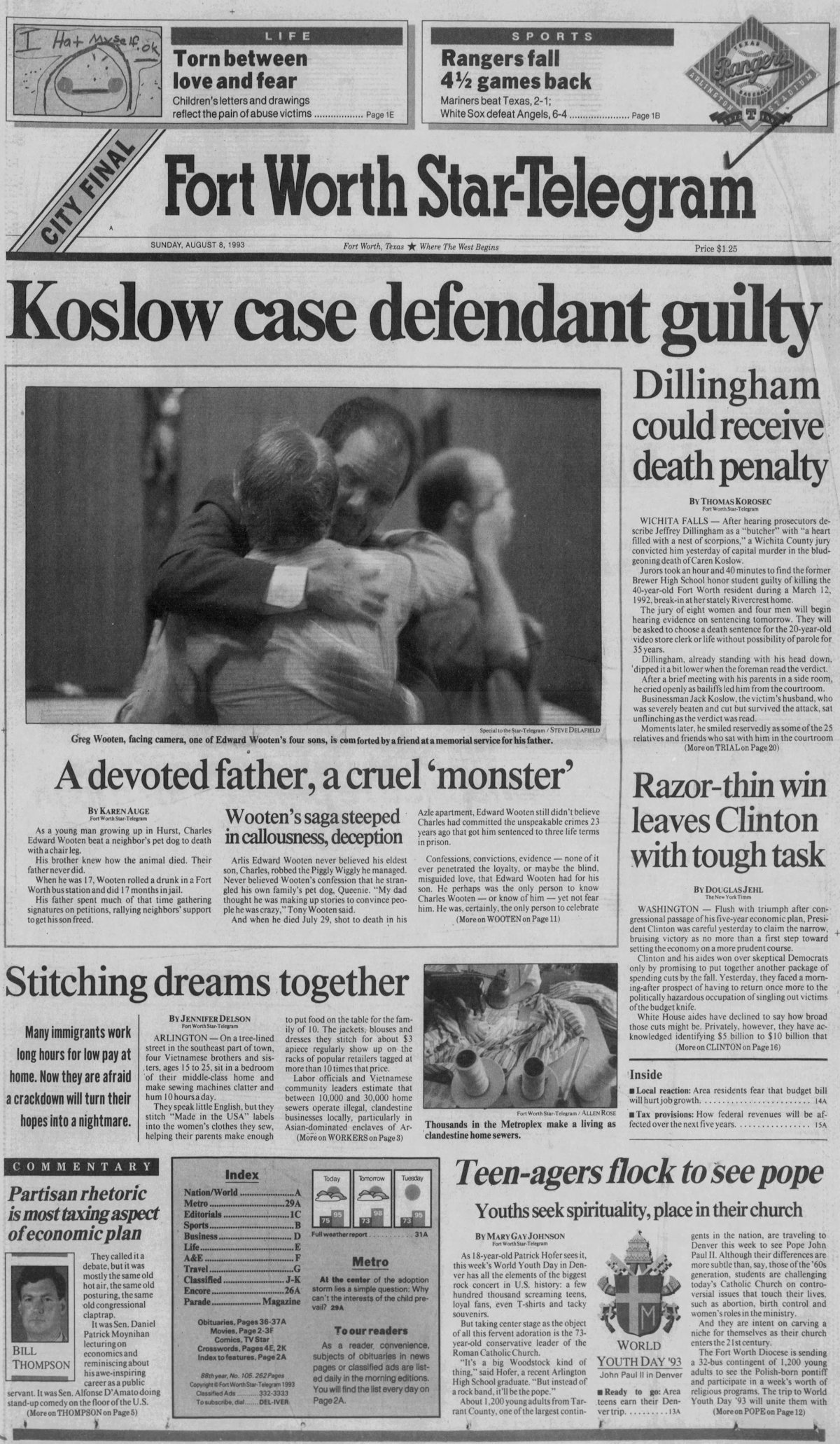 Jeffrey Dillingham gambled and lost: The jury found him guilty of murder.
Jeffrey Dillingham gambled and lost: The jury found him guilty of murder.
 And sentenced him to death.
And sentenced him to death.
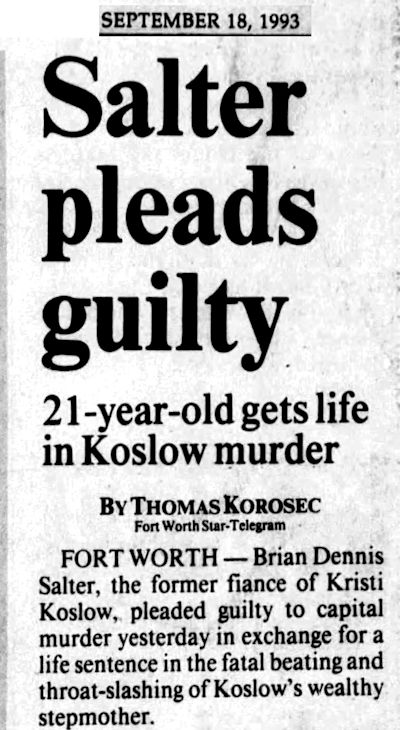
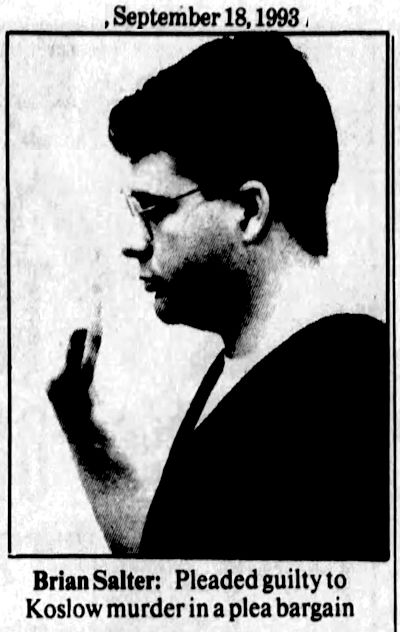 Brian Salter did not want to follow in Jeffrey Dillingham’s footsteps to Death Row. Salter chose not to gamble. He pleaded guilty to get a life sentence in exchange for testifying against Kristi Koslow.
Brian Salter did not want to follow in Jeffrey Dillingham’s footsteps to Death Row. Salter chose not to gamble. He pleaded guilty to get a life sentence in exchange for testifying against Kristi Koslow.
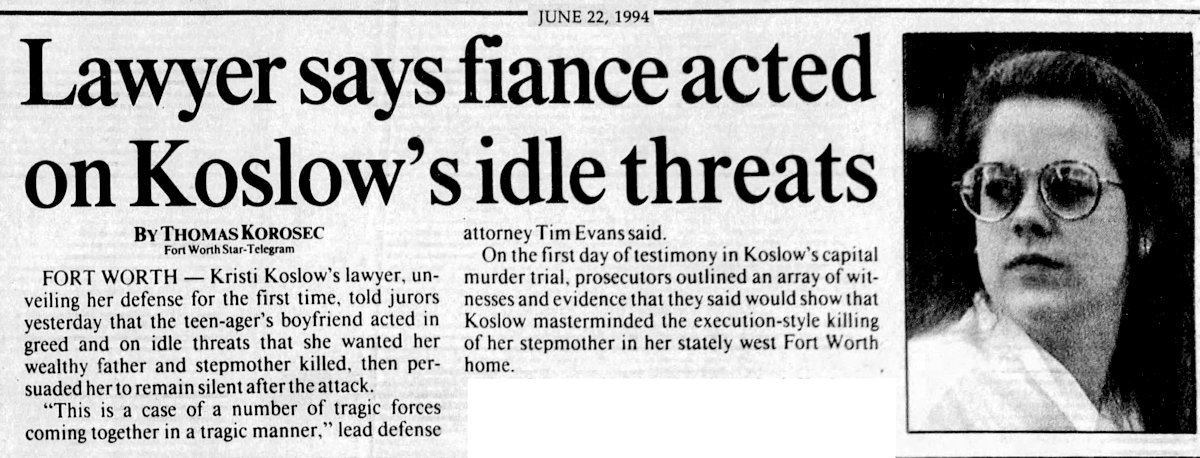 Kristi Koslow went on trial in August 1994. The state asked the death penalty.
Kristi Koslow went on trial in August 1994. The state asked the death penalty.
Lead defense attorney Tim Evans told the jury that Salter and Jeffrey Dillingham were the masterminds of the crime, taking a cue from Kristi’s idle talk about wanting her parents dead.
Evans said most of Kristi’s friends considered her talk of wanting to see her parents dead to be “popping off” or “a joke.”
But Brian Salter, Evans said, was “a person who had nothing going for him [and] had one thing in mind—getting a bunch of money.”
“Brian Salter and Jeffrey Dillingham planned this murder,” Evans said, and then persuaded Kristi Koslow to remain silent.
Evans also attacked Salter’s plea bargain, pointing out that Salter was testifying for the state to save his life.
“As he sits in this chair,” Evans said, pointing to the witness stand, “that death penalty is hanging over his head.”
Prosecutors, led by Alan Levy, countered that Kristi Koslow masterminded the crime.
Levy told the jury that Kristi Koslow provided Salter and Dillingham with a map of her father’s house and a code to disarm its security system.
“They knew exactly which door to kick in,” Levy said. “They were able to navigate through a four thousand-foot home in pitch dark.”
Taking the stand, Brian Salter testified about how the murder plan took shape: Conversations among Salter, Dillingham, and Kristi Koslow evolved from talk of burglarizing the Koslow house to talk of killing Salter’s parents to talk of killing Salter’s parents and Koslow’s parents. Finally, Salter testified, the plan settled on killing just the Koslows.
 And Jack Koslow again took the witness stand, again described the attack on the night of March 12, 1992.
And Jack Koslow again took the witness stand, again described the attack on the night of March 12, 1992.
He also said he wanted to see his daughter put to death for killing his wife.
“You would recommend she get the death penalty?” defense attorney Evans asked Koslow.
“Yes, sir,” Koslow said in a low voice. “That’s what she gave Caren.”
Jack Koslow had just returned his daughter’s kiss of Judas.
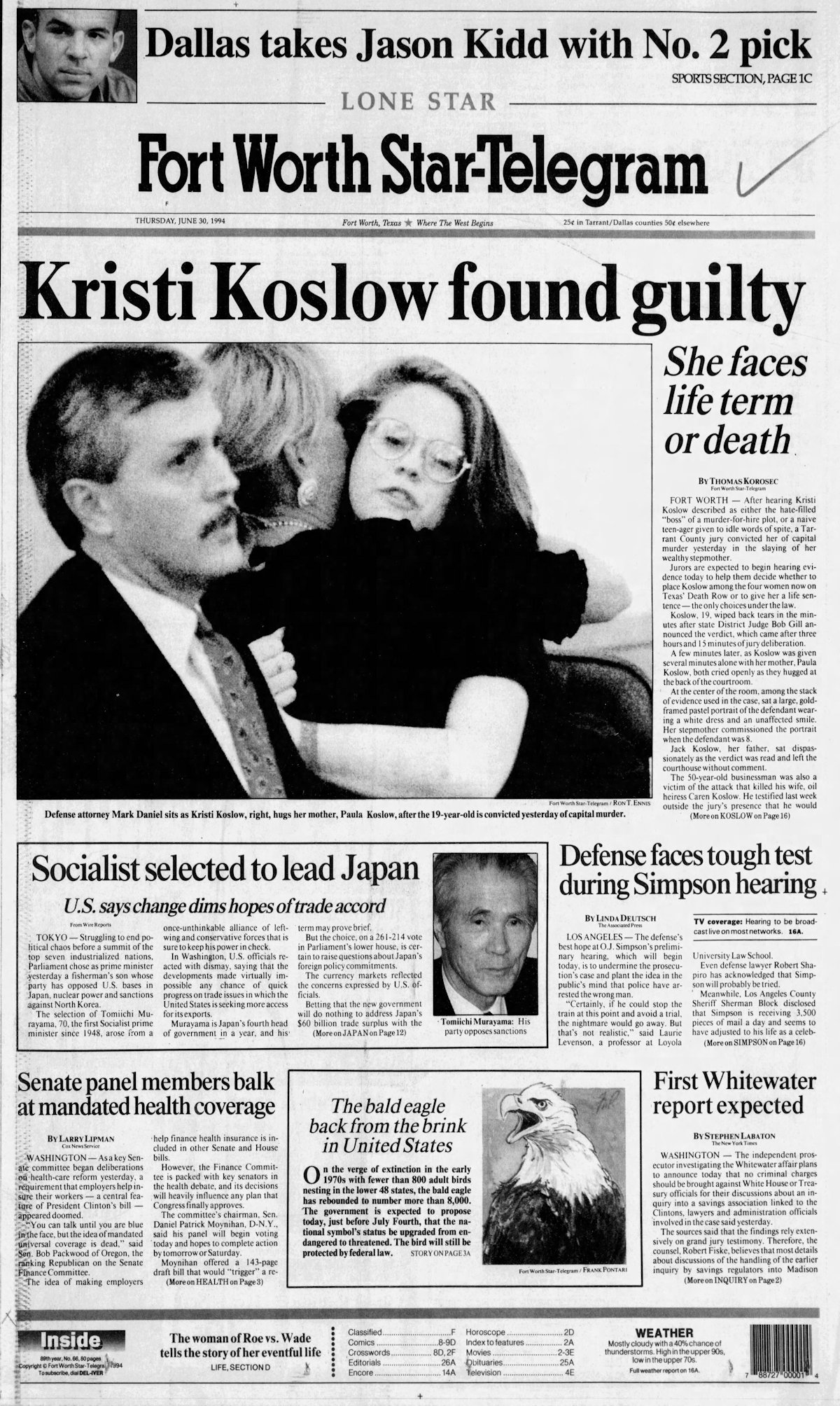 Jurors had little difficulty finding Kristi Koslow guilty of murder but were undecided on the question of whether she posed a future threat to society—a requirement for the death penalty in Texas.
Jurors had little difficulty finding Kristi Koslow guilty of murder but were undecided on the question of whether she posed a future threat to society—a requirement for the death penalty in Texas.
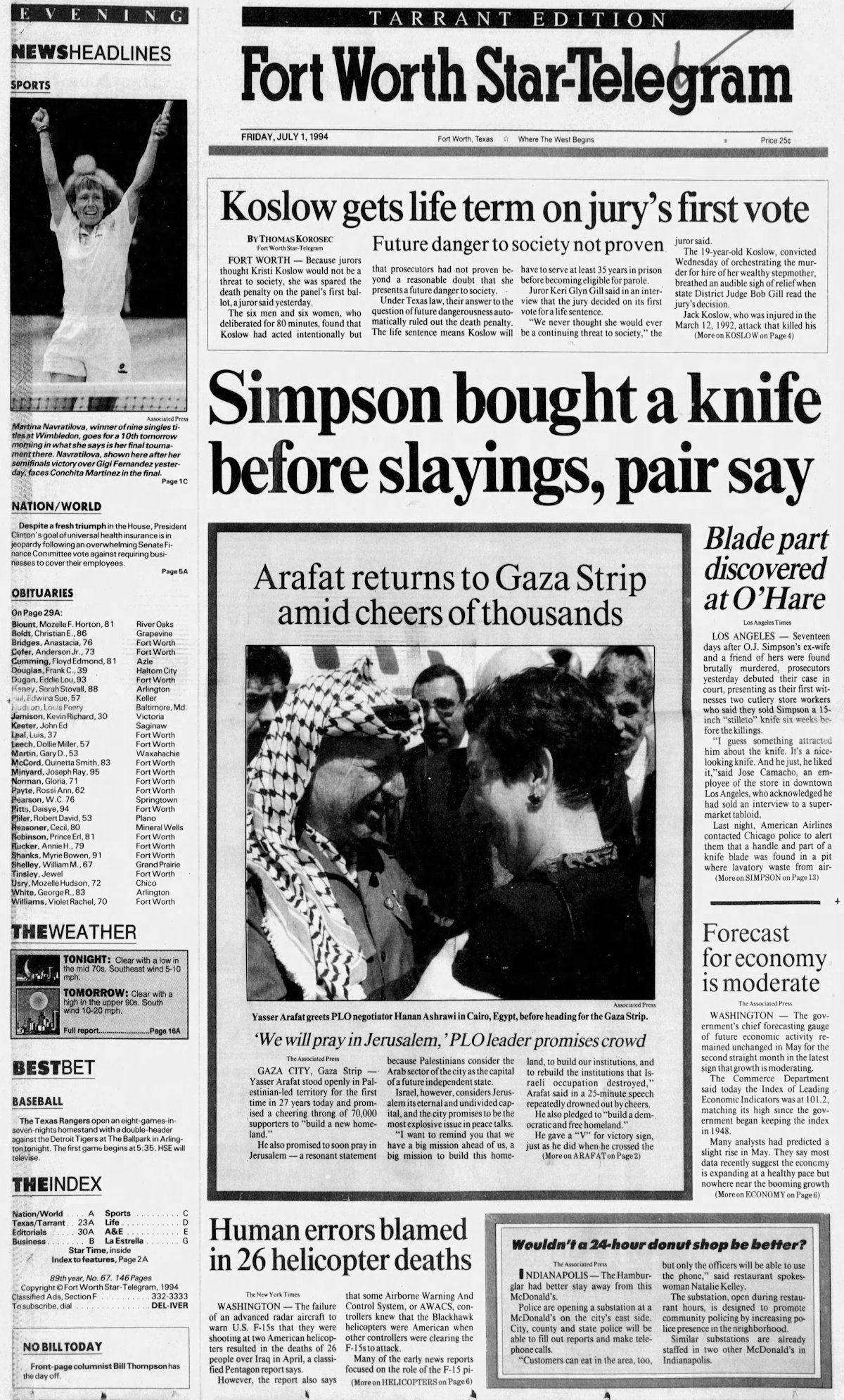 When the jury delivered a sentence of life imprisonment, Kristi Koslow sighed in relief.
When the jury delivered a sentence of life imprisonment, Kristi Koslow sighed in relief.
She shared the front page with another murder trial that involved a knife.
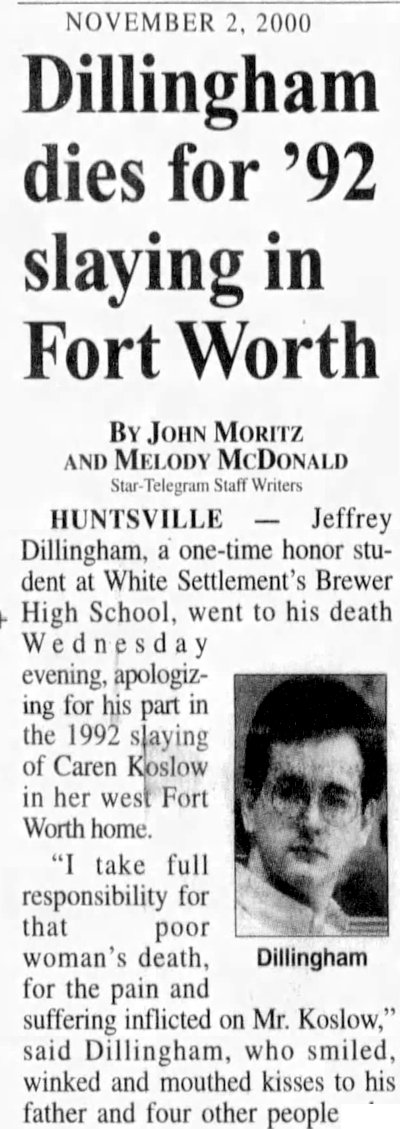 On the night of October 31, 2000—Halloween night—anti-death penalty demonstrators stood in the rain holding candles outside Huntsville penitentiary.
On the night of October 31, 2000—Halloween night—anti-death penalty demonstrators stood in the rain holding candles outside Huntsville penitentiary.
Among the demonstrators was Lois Robison of Burleson, whose son, Larry Keith Robison, had been executed in January. Lois Robison was in Huntsville to comfort members of the Dillingham family who had come to say farewell to Jeffrey.
The next day Jeffrey Dillingham, from the prison, telephoned his family members, who were staying at the nearby Hospitality House.
Robison said, “He called, and we put him on speaker phone. He basically said that he loved everyone. He led us in singing ‘Amazing Grace,’ all the verses.”
Two hours later Jeffrey Dillingham was executed by lethal injection.
As of 2022 Kristi Koslow was an inmate at the Hobby Unit for women in Falls County. Brian Salter was an inmate at the Alfred Hughes Unit in Gatesville.
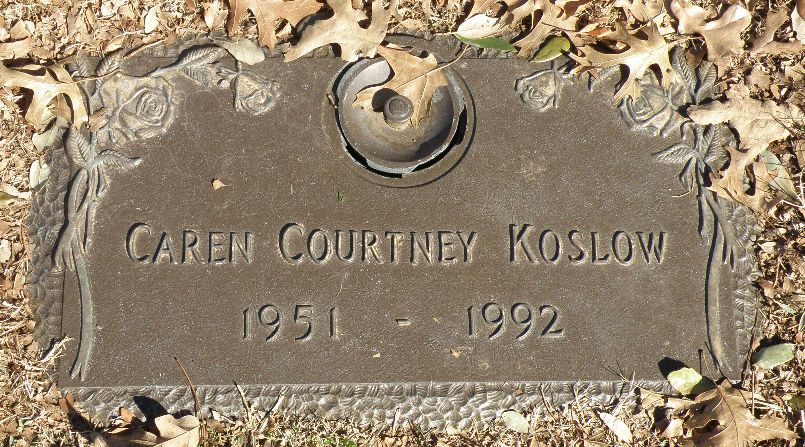 Caren Koslow, whose death proved that “all of the alarms, all of the security systems couldn’t stop” murder, is buried in Greenwood Cemetery.
Caren Koslow, whose death proved that “all of the alarms, all of the security systems couldn’t stop” murder, is buried in Greenwood Cemetery.






….. Yes Mary we should never look back at history, where you see offense I find none…..
How offensive to write this and much less have someone post it….and the words “dead is dead”…..really? Caren was a lovely, lovely woman….she has family that still lives here along with her former husband…this isn’t even an anniversary…I guess just a cheap attempt at attention at the expense of a wonderful family…
This has to be so horrible for the family. I can’t imagine the hell they have had to deal with and for such a foolish reason. My heart goes out to them. I know it’s been a while but I’m sure to them it can feel like yesterday. I am so sorry these innocent people have had to suffer.